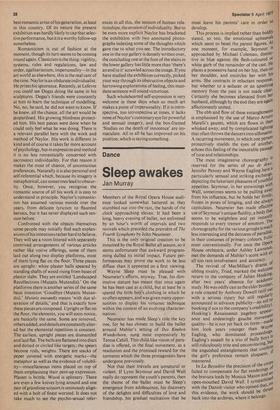Dance
Sleep awakes
Jan Murray
Members of the Royal Opera House audience looked somewhat battered as they stumbled out into the rain, the hands of the clock approaching eleven. It had been a long, heavy evening of ballet, not enlivened by an hour's worth of intervals and two revivals which preceded the premiere of The Fourth Symphony by John Neumeier.
This is the only original creation to be mounted by the Royal Ballet all season, so it seems unfortunate that awkward programming dulled its initial impact. Future performances may prove the work to be less diffuse than it appeared on a first viewing.
Wayne Sleep must be pleased with Neumeier's efforts, anyway. True, his diminutive stature has meant that once again he has been cast as a child, but at least he is spared the little boy's clothing in which he so often appears, and was given many opportunities to display his virtuosic technique within the context of an evolving characterisation.
Neumeier has made Sleep's role the key one, for he has chosen to build the ballet around Mahler's setting of Des Knaben Wunderhorn, sung most expressively by Teresa Cahill. This child-like vision of paradise is offered, in the final movement, as a resolution and the promised reward for the torments which the three protagonists have undergone previously.
Not that their travails are unnatural or violent. If Lynn Seymour and David Wall really do represent the youth's parents, then the theme of the ballet must be Sleep's emergence from adolescence, his discovery of the delights and difficulties of love and friendship, his gradual realisation that he must leave his parents' care in order to develop.
This process is implied rather than boldlY stated, so too, the emotional upheavals which seem to beset the parent figures. At one moment, for example, Seymour is approached by Michael Coleman, distinctive in blue against the flesh-coloured or white garb of the remainder of the cast. He places a possessive hand on her hip, then on her shoulder, and encircles her with his arms. She contracts in reluctant response, but whether to a seducer or an upsetti18 memory from the past is not made clear. Certainly she becomes alienated from her husband, although by the end they are again affectionately united.
The ebb and flow of these entanglements is emphasised by the use of Marco Arturo Marelli's gauzes, which are flown in then whisked away, and by complicated lighting that often throws the dancers into silhouette. A recurring movement, in which one person protectively shields the eyes of another, echoes this feeling of the inexorable passage of time and relationships. The most imaginative choreographY j5 reserved for the series of pas de deux. Jennifer Penney and Wayne Eagling have a particularly sensual and striking exchange; depicting the luxuriant pleasures of youthful appetites. Seymour, in her entwinings Wit Wall, sometimes seems to be pulling away from his influence, but he holds her firmlY• frozen in poses of longing, and she alwaYs capitulates. Neunneier has made effective use of Seymour's unique fluidity, a body that seems to be weightless and yet instantlY responds to every tremor of emotion. choreography for the various groups is muci' less interesting and the denizens of paradise,' in their costumes of primary colours, frolic most conventionally. For once the OP era House orchestra, under Ashley Lawrence, met the demands of Mahler 's score with a° all too rare involvement and accuracy. The revival of MacMillan's drama °I sibling rivalry, Triad, marked the welcoole return to the company of Julian Hosking, after two years' absence for acadenne study. He was oddly cast as the elder brother; a role created by Anthony Dowell (still on with a serious injury but still regularloY announced in advance publicity—an aid t booking if not to the company's credibilitY). Hosking's Renaissance pageboy aPPear: ance and endearingly gauche movenlein; quality—he is not yet back on form—n-13°e him look years younger than WO° Eagling, who dominated proceedings.: Eagling's assault by a trio of bully boy's ist still ridiculously trite and unconvincing, the anguished entanglements that conn the girl's preference remain eloquent, mannered. In La Bayadere the precision of he C° failed to compensate for flat renderings the bravura leads by Monica Mason and open-mouthed David Wall. I sympathise° with the Danish visitor who opined that, os nt this evidence, the work should be thru back into the archives, where it belongs.
































 Previous page
Previous page